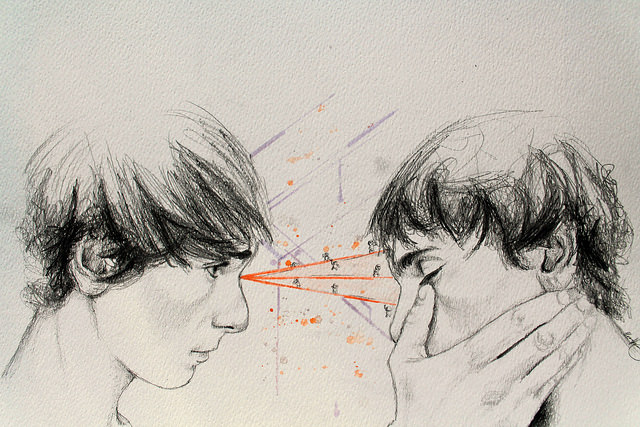While meditating, I sometimes find myself laughing and crying simultaneously.
It’s a soothing and sometimes odd position to be in when the mind can’t distinguish between the two. Yet, it is in this space where everything, everywhere seems to make like The Beatles and come together.
That Möbius strip of interconnectedness between those two bodily actions is an apt comparison to being. Known by many names, some call this state of mind and body “being present,” others have dubbed it “being in the now,” perhaps two of the most popular phrases are “going with the flow,” or “in the moment.”
Whatever the flavor of phrase, there is an extensive list of words out there that describe the art of being, and these words have the potential to make this state of mind and body easily relatable. Despite this, for something that is considered effortless for many, there is still a degree of difficulty involved when it comes to describing the art of being, not only to others who meditate, but especially to those who don’t.
For starters, in and of itself meditation is a partially subjective experience that, over time, encourages the mind to become more objective. What also makes meditation difficult to explain is the fact that data driven and scientific research into meditation only started in the last 60-ish years, so there’s still much insight to be gleaned. This article is an attempt to bridge the gap and explain the art of being.
Why Being?
The term meditation can be a bit misleading, as the root of the word’s origins is the Latin “meditatum,” meaning “to ponder,” which isn’t exactly what meditation is all traditionally about.
Even if one were to strip away most of the philosophy behind meditation, it becomes clear that at the very least, meditation is, in traditional circumstances, about being able to simply lay, sit, stand or walk with oneself, without judgement of anything, either internal or external.
Despite the fact that many would deem it to be a simple practice, meditation isn’t that easy. This is because our brains are essentially hardwired to analyze and store information, while simultaneously keeping us alive through a combination of the autonomic nervous system and amygdala (the brain’s fear center). Not to mention that many parts of western civilization encourage a rush-around, carrot-dangling mentality that is almost constantly stimulating the brain’s fear center and the medial prefrontal cortex (the brain’s “Me Center”).
In other words, because the brain’s fear-based survival mechanisms are amplified in certain cultures, we end up strengthening neural connections in our brain between the me center and fear center, thus producing an over reliance on these areas of the brain, which in turn explains why many often become stuck in broken record thought loop habits about the past or the future.
We don’t even realize how entangled we can become in our own thought patterns on a neurological level.
For example, the first time I felt myself laughing and crying simultaneously, I noticed my mind was doing its best to understand this reaction, and I found myself wondering if I was happy or sad, upset or in bliss, and other ways of attempted labeling. The labeling of objects, at its core, is a survival mechanism. This isn’t to say it is something negative, as it helped ancient humans differentiate between plant life that was and was not safe to consume. It still does. However, we’ve evolved a little bit more since that time, and in modern society our minds are also labeling thoughts and feelings among other things. But it still evokes a mind for survival.
All of this also happens to have an impact on breath, controlled in part by the autonomic nervous system.
Breath is perhaps the most underrated tool in the body. Many meditation techniques encourage focus on breathing. When focusing on breath, it serves as a reminder we have survived, that we are alive.
A common practice is to focus only on each inhalation and exhalation, and should any thoughts arise, simply acknowledge that it happened and return focus to the breath. Not only does this common practice allow us a focused method of oxygenating our brain, but overtime, focusing on the rhythms of each inhalation and exhalation, one may start to see that breath is the vehicle to understanding ourselves and the world around us, both of which are vast and profound, especially after we’re able to untangle from thoughts.
In recent years, much more research is available in regard to the benefits of meditation. One of the most striking discoveries reveals how the neural connection to the area of the brain, which processes any and all information relating to our own experiences and perspectives, weakens. In turn, over time, we are creating new and potentially healthier neural pathways and connections.
When we don’t take time to be with ourselves by simply breathing, we aren’t taking time to understand our own profound awareness and intuition. In turn, we are ignoring some of our internal rhythms, not to mention our ability to recognize thought patterns and how to detach from them. But with enough practice focusing on breath, we naturally detach from the emotions associated with our thoughts, thus allowing a certain awareness of ourselves to see that many of us probably have habits that go beyond the every day like waking up in the morning or biting one’s nails. After a while, this awareness also brings subconscious habits to the surface as well.
The art of being allows us the ability to see the ebb and flow of our own mind. It is here, in this detachment, that we may discover that being is eternal and infinite.
If one is truly operating on a level of being fully present, having completely surrendered in the now-ness, one may eventually see that now is a never-ending ocean of all things. There is no destination. This doesn’t mean one is immobile. One can swim in any direction, but must also remember there is no destination.
When we’re being present, we can see endless possibilities. At first this might feel overwhelming, but eventually this brings about a certain serenity. It is in this serenity that we understand nothing is exactly as it is remembered and nothing will be exactly as it is wished. That is why we have the present—to be exactly what and where we need to be.
Here, when we focus on our breath, we come to see there is nothing for us to look forward or back at, but everything to look at now.
And when we are being, it is often, but not always, a lovely experience because we are giving ourselves time and permission to be in silence. I like to call this silence “the eye of the storm.” As a consequence, this awakens the possibility to discover and recognize hidden pains and obstacles (often in the subconscious) that are otherwise nearly impossible to see, due to the constant stream of information the mind is always downloading about the surrounding world.
But as a result of unearthing these hidden things, most everyone’s journey of finding silence can sometimes be fraught with turbulence. As the old saying goes, “Sometimes it’s hell trying to get to heaven.” Getting to that present moment of silence within the eye of the storm involves a surrender to the present moment and a release of any judgments, regrets, and expectations.
If old traumas or hurtful thoughts do arise, it’s important to remember this is okay too, as it shows one is ready to process and move through these thoughts, feelings, emotions and desires. Acknowledging and accepting they exist is a huge and quite profound step, but it is not the only step.
One still needs to embrace and release these thoughts, feelings, emotions and desires. Release can occur in a variety of ways, but it is important to remember release doesn’t mean wipe out completely. Some things take a long time to heal. And if one is unable to do this through personal meditation, that too is alright—talk therapy or other kinds of therapy can also be beneficial in trying to reach that place of silence.
But the cool thing is, anyone can reach that. That’s the wonderful thing about silence, it’s one size fits all.
This silence continues to fit as I grow in my meditation. Now, should I happen to find myself in a position to experience simultaneous laughter and crying, I do not judge myself or try to label what is going on. Instead, I simply experience it as it happens, being present with myself.
Through surrendering to the present, one can see the day is full of present moments.
Sometimes the present moment is when we are with others. It is when we are being in these moments, moving through and honoring them with whatever amount of integrity we possess, that the ripples of our actions can potentially make waves, not just for others but ourselves.
That is the true art of being.
Author: Bryce Post
Editor: Emily Bartran
Photo: lucahennig/Flickr
 Share on bsky
Share on bsky




Read 2 comments and reply